Max Factor (post 1960)
Continued from: Max Factor (1945-1960)
On April 11, 1961, Max Factor made a public offering of 400,000 shares of class A stock enabling the company to list on the New York Stock Exchange (NYSE). The company’s share price now became more of a consideration in its decision making which put an emphasis on growth.
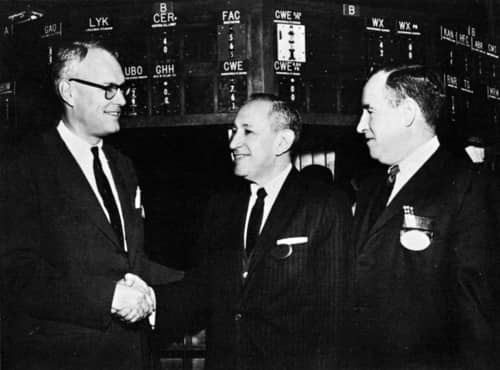
Above: 1961 G. Keith Funston, President of the New York Stock Exchange shakes hands with Davis Factor while Andrew J. Corcoran of Carreau & Company looks on.
By 1961, manufacturing in the United States had been largely consolidated at the plant in Hawthorn, California by which time, sales and earnings had reached a record high of nearly US$63 million. These would grow to over US$187 million by 1970, an increase that went in tandem with an extensive building and refurbishment program.
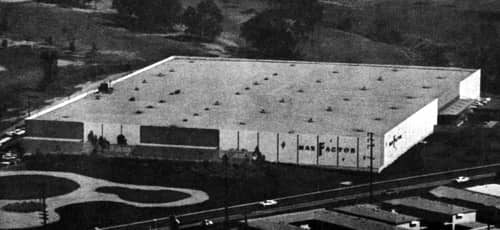
Above: 1961 The Max Factor plant in Hawthorn, California.
In 1962, a new mid-west distribution centre was constructed in Des Plains, Illinois, near the O’Hare International Airport; extensions to the Hawthorn plant were completed in 1963; a New York office was opened on the 21st Floor of the Bankers Trust Building at 280 Park Avenue in 1964; a new western distribution centre was constructed in Gardena, California in 1965; the cosmetic research and production development laboratory in the McCadden building was extended and refurbished in 1967; and the company’s executive offices were relocated to the new Max Factor Building at 6922 Hollywood Boulevard, directly opposite Grauman’s Chinese Theatre, in 1967.
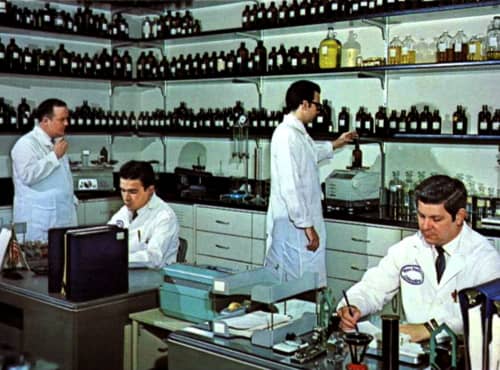
Above: 1967 A laboratory at the Cosmetic Research and Product Development Laboratories at the North McCadden Place Building.
In 1970, with additional production space still needed, the western distribution centre was moved from Gardena to the City of Industry, California and the site in Gardena was then converted over for manufacturing.
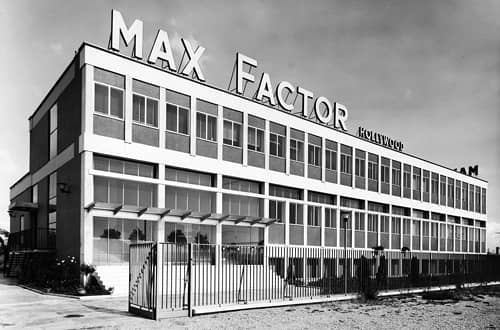
Above: 1960 Max Factor factory in Milan.
Overseas, the company opened new branches in Puerto Rico (1963), El Salvador (1967), and Indonesia (1970) with manufacturing plants built or extended in Milan (1960); Canada, Japan and Guatamala (1963); England (1964); Sweden and Mexico (1967); the Dominican Republic and Jamaica (1968); Japan, Argentina and Brasil (1969); and Argentina, England and Indonesia (1970).
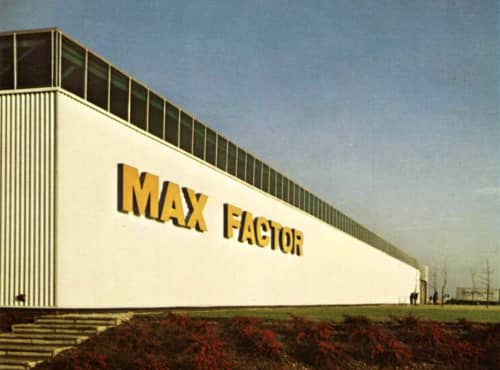
Above: 1969 New additions to the Max Factor Distribution and Warehouse Centre near the British manufacturing plant in Bournemouth, England.
Brand image
Having lost its close affiliations with Hollywood, Max Factor began redefining itself as ‘uniquely Californian’. Not all of Max Factor’s promotions featured California but the name was invoked more commonly in marketing campaigns than anything else. Examples included: ‘California Case Mates’ (1960), ‘Pick a Californian Orange’ (1961), ‘Ooh La California’ (1962), ‘California Mad Mad Colors’ (1963); ‘California Bronze’ (1963), ‘California Sun Glosses’ (1966), ‘California Pink-A-Pades’ (1967), ‘The California Bold Blush is On’ (1968), and ‘The California Ices’ (1969).
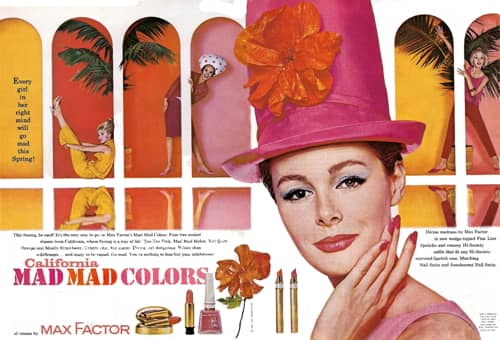
Above: 1963 Max Factor ‘California Mad Mad Colors’ promotion. Shades: Too Too Pink, Mad Mad Melon, Not Quite Orange and Mostly Strawberry in Hi-Society and Fine Line Lipsticks and Nail Satin, with Too Too Pink and Mad Mad Melon also in Super-Iridescent Nail Satin.
As well as redefining its image, Max Factor moved to continue to improve those eareas in which it was weak – fragrances, nail polishes, the youth market, men’s toiletries and hair-care – while engaging with the more pressing developments of the decade – the natural look, eye make-up and moisturisation.
Fragrances
Max Factor had sold a limited number of imported french perfumes before the war including Le Parfum Max, Coconut Grove and Trocadero. In the 1950s, the company began to get more seriously into perfumes releasing Signature (1950), Golden Woods (1951) and Autograph (1953) before creating its first domestically produced fragrance, Electríque (1954), as a perfume, cologne, bath oil, soap and dusting powder.
In July, 1961, Max Factor strengthened its position in perfumes by acquiring all the outstanding stock of Parfumerie Internationale Corday, Paris – a French perfume house established by Blanche Arvoy (née Reneaux) in 1924 – as well as Parfums Corday, Inc., New York and its various subsidiaries. This gave Max Factor ownership of perfumes such as Toujours Moi, Fame, Jet and Trapeze.
New fragrances that followed included Possession (1964) and Promesse (1966) which were used in a wide range of products such as perfumes, bath oils, colognes and dusting powders.
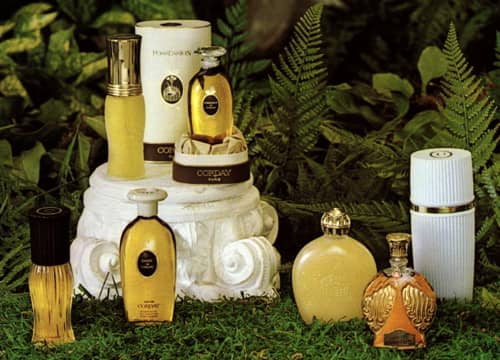
Above: 1967 Possession by Corday.
Hair-care
A second weakness for Max Factor had also been improved through acquisition, when Max Factor acquired Lee Ltd. – the makers of Sof-Set hair products – in 1956. In 1964, Max Factor released Coiffure Italianne – a protein enriched hair-setting gel and highlighter in seven shades – in the United States, a product had been first developed overseas.
Seeing a need for more research in this area, Max Factor established the Color Hair Institute in the McCadden Building, Hollywood in 1967, the same year it released Tried & True, a shampoo-in soft colour for hair.
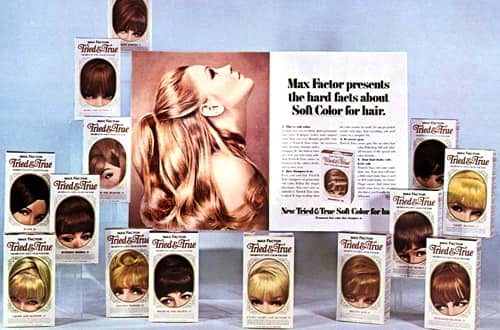
Above: 1967 Max Factor Tried & True Shampoo-In Soft Colour for Hair.
Other Tried & True products followed including: Tried & True Extra-Creamy Pre-Lightening Kit and Tried & True Shampoo-In Soft Color Blonde Toner (1968); Tried & True The Beautiful Brunettes, and Tried & True Protein Instant Conditioner for Hair (1969); and Tried & True California Blonde, and Tried & True Soft Hair Spray (1970).
Also see the company booklet: Tried & True (1967)
Pure Magic
A third weakness for Max Factor was the growing youth market. The company had added Clear-Up, Skin Clear Medicated Cleanser and Skin Clear Medicated Foam in the 1950s but did not have a make-up range aimed specifically at the younger generation.
The arrival of Noxema’s Cover Girl Liquid Make-up and Compressed Powder in 1961 seems to have galvanised Max Factor into action. In 1962, Max Factor introduced Pure Magic Medicated Cake Make-up in eight shades and Pure Magic Medicated Compact Make-up in three shades, most likely antiseptic versions of the company’s Pan-Cake and Creme Puff Make-up respectively.
Like Cover Girl, Pure Magic was aimed at the 16-25 year age group and was medicated with hexachlorophene. In 1963, Max Factor added Pure Magic Medicated Liquid Make-up in a tube, perhaps based on Sheer Genius Make-Up released in 1960. By then, company was producing all three products in the Pure Magic range in eight shades which included: Soft Beige, Candle Glow, Fair Tone, Truly Fair, Twilight Blush, Gay Whisper and Fair Dawn.
Pure Magic: “New one-step medicated fashion make-up slips on like a smooth new complexion, clearing blemishes from sight instantly. Foundation . . . Matte Finish . . . Medication in one! Pure Magic Fools the eye with sleekest, smartest coverage . . . shelters you with an antiseptic that helps stop bacteria spread, so often the cause of skin problems. No layered look, no compromise colors . . . Pure Magic stays fresh as it starts, never streaks or changes color.”
See also: Cover Girl
In 1968, Max Factor added skin-care products to the line, namely Pure Magic Medicated Cleansing Gel for use before retiring, and Pure Magic Medicated Toning Lotion for refreshing and stimulating the skin during the day. When used together they were said to protect and medicate the skin, help to heal blemishes, cleanse the pores, help loosen blackheads and cleanse the skin of excess oil as well as making it easier to apply make-up and make that make-up last longer.
Pure Magic cosmetics were not the only medicated products Max Factor developed during this period. A medicated version of Erace and Pan-stik called Erace Plus and Pan-Stik Plus were introduced in 1965 and 1970 respectively. The medicated Erace was also added to Pure Magic line as Pure Magic Medicated Cover-up Stick.
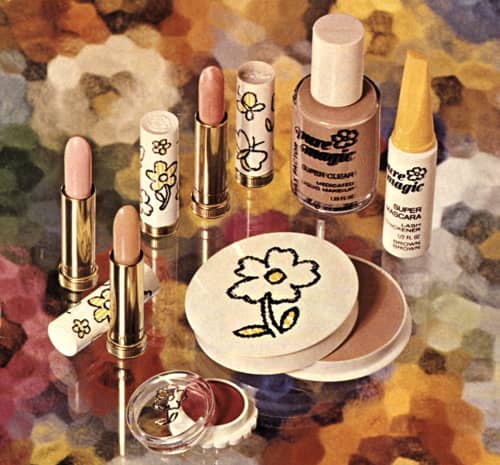
Above: 1971 Max Factor Pure Magic make-up.
After 1972, Pure Magic was no longer branded as medicated, presumably because the Food & Drug Administration (FDA) had mandated the removal of hexachlorophene from cosmetics in 1972. This must have been a blow as the range had just been expanded with new lines generally labelled with ‘Super’ such as Pure Magic Super Blotter, a pressed powder, and Pure Magic Super Blusher (1969); Pure Magic Super Sheer Medicated Liquid Make-up, Pure Magic Super Cover Medicated Cake Make-up and Pure Magic Super Lip Gloss (1970); and Pure Magic Super Eyelashes (1971).
See also: Hexachlorophene
After references to medication were dropped, Pure Magic was advertised as dermatologically tested and hypoallergenic. The range continued to expand through the 1970s – sold through self-service floor stands and counter boutiques, places where 16-25 year-olds were likely to shop – becoming a full make-up line which included products such as Pure Magic Super Cheek Gel, Pure Magic Super Lip Gloss, Pure Magic Super Gloss Stick, Pure Magic Super Shadow, Pure Magic Super Eye Gloss, Pure Magic Super Mascara, Pure Magic Super Eye Maker and Pure Magic Nail Polish.
Foundations and face powders
As mentioned earlier, Max Factor introduced Sheer Genius Make-Up, a creamy, liquid make-up packed in tubes in ten matt shades, in 1960. Sheer Genius Extra Cover, for women who wanted a more opaque make-up, was introduced in 1961 after which the original Sheer Genius was reformulated and rebranded as Sheer Genius Natural Finish Formula.
Sheer Genius: “[A] complete make-up in itself. In one easy step Sheer Genius gives your complexion a lovely lustre and a flattering softness—a flawless‘matt’ finish that is never shiny never powdery. Shades: Soft Beige, Candle Glow, Fair Tone, Truly Fair, Twilight Blush, Gay Whisper, Fair Dawn, Tempting Touch, Radiant Beige, and Sun Tone.
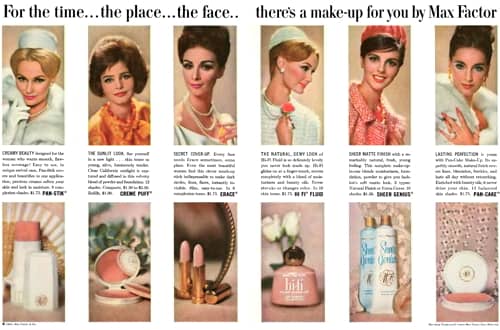
Above: 1963 Max Factor Pan-Stik, Creme Puff, Erace, Hi-Fi Fluid, Sheer Genius and Pan-Cake make-up.
The addition of Sheer Genius meant that Max Factor now had foundations in compact, liquid, cream, stick and cake forms. These came in a range of colours designed to match skin tones that were organised into three main shade groups: Beige-Rose shades for normal skins; Rose-Beige shades for sallow skins that required added colour; and Beige shades for ruddy skins which needed their redness reduced.
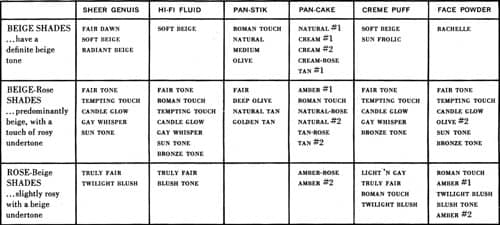
Above: Max Factor shades ranges for Sheer Genius, Hi-Fi Fluid, Pan-Stik, Pan-Cake and Creme Puff foundations, and Face Powder.
Also see the company booklet: New Make-up Color Fashions by Max Factor (c.1962)
One factor that would determine which of these foundations a woman selected was coverage. Sheer Genius Natural Finish Formula, Hi-Fi fluid Make-up and Cream Puff all gave a sheer or light coverage; Sheer Genius Extra Cover Formula or Pan-Stik Makeup could be used if medium coverage was required; while Pan-Cake Make-up gave maximum coverage. A woman who wanted a colourless make-up could use Invisible Make-up Foundation. All of these foundations could be followed with Max Factor Translucent Creme Puff, Translucent Face Powder (1959) no-colour, translucent powders that allowed the natural skin tones or shade of underlying make-up foundation to show through or Finishing Powder (1961) in three shades to give the skin a matt finish.
Finish Powder: “[A] translucent pressed powder that adds a soft, matte finish to any make-up. It applies invisibly, imparting delicate natural beauty.” Shades: Translucent Beige-Rose Tone, Translucent Rose-Beige Tone and Translucent Beige Tone.
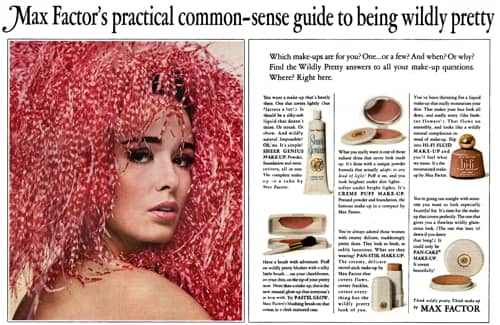
Above: 1966 Max Factor Sheer Genius Make-up, Pastel Glow Blusher, Creme Puff Make-up, Pan-Stik Make-up, Hi-Fi Fluid Make-up and Pan-Cake Make-up.
All of these forms of make-up were continued through the 1960s and forms of them were used in the three new ranges Max Factor introduced in the 1960s – Pure Magic (1963), UltraLucent (1965) and Geminesse (1966).
The company also added new compacts during the decade, such as ‘California Case Mates’ (1960), ‘Sunlit Look’ (1962), and the elegant ‘Regency Thin Line Compacts’ (1964).
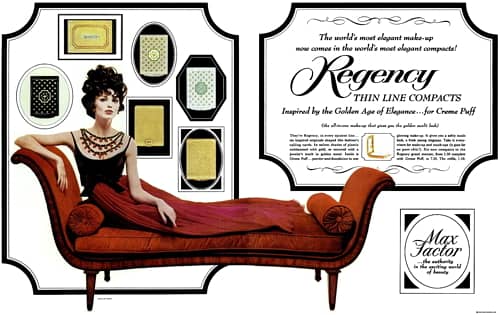
Above: 1964 Max Factor Regency Thin Line Compacts.
Nail polish
Another problem for Max Factor was nail polish. The increased emphasis on matching nail polish with lipsticks – begun in earnest by Revlon’s 1940 ‘Matching fingertips and lips’ campaign – meant that Max Factor needed to improve its nail polish and make it available in a wider colour range if it was to maintain its sales of lipsticks.

Above: 1961 Max Factor Nail Satin.
The new Nail Satin range (1961) came in twenty shades in matt and iridescent finishes in colours that matched Max Factor lipsticks, including shades from the Max Factor ‘Ooh La California’, ‘California Sun’ and ‘Autumn Sun’ promotions running that year.
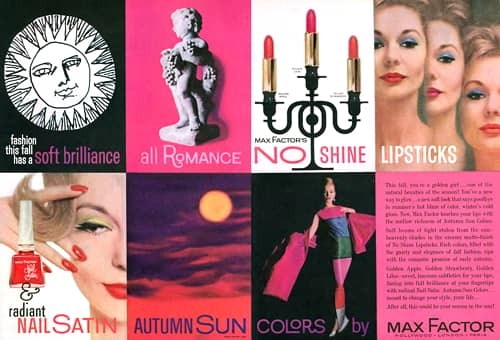
Above: 1961 Max Factor ‘Autumn Sun’ promotion. Shades: Golden Apple, Golden Lilac and Golden Strawberry in Hi-Society Lipsticks, and Nail Satin.

Above: 1961 Nail Satin and matching lipstick shades.
Along with Nail Satin came Nail Satin Base Coat, Nail Satin Top Coat and Nail Satin Matt Base, the last product being a base coat for matt shades.
See also the company booklet: Max Factor Nail Satin (c.1961)
Jewelescent Nail Satin shades – Sol-La Strawberry, Coralatura, A Cappella Beige, Pink Tone Pink, Fiddle-De-Pink, and Clear Note Red – were added in 1962; thereafter, new shades were released in gloss, matte and iridescent forms concurrently with new lipstick colours.
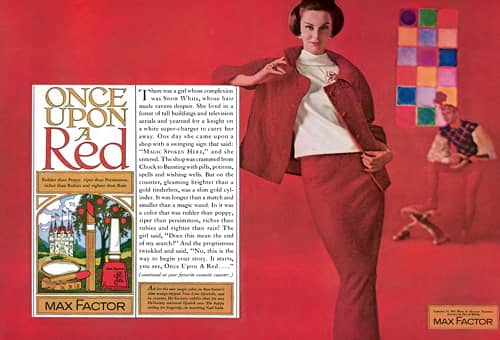
Above: 1963 Max Factor ‘Once Upon A Red’ promotion. Once Upon A Red shade in Fine Line and Hi-Society Lipsticks, and Nail Satin.
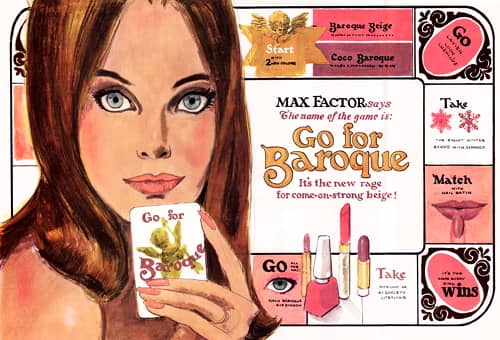
Above: 1964 Max Factor ‘Go For Baroque’ promotion. Baroque Beige and Coco Baroque shades in Fine Line and Hi-Society Lipsticks, and Nail Satin with Shadow Stick in Coco Baroque.
Also see the counter display: Once Upon a Red (c.1963) and booklet: Go for Baroque (c.1964)
Max Factor later added a number of supplementary products to its nail-care range including Stronghold, a nail mender and strengthener (1966), and Fortify Instant Nail Mend and Fortify Instant Nail Conditioner (1970).
Stronghold: “A revolutionary hail coating discovery that instantly mends broken nails . . . strengthens fragile nails and actually allows your nails to grow longer!”
The Nail Satin line of nail polishes was depreciated somewhat with the introduction of UltraLucent Nail Color with a ‘built-in’ top coat in 1968 and the addition of Pure Magic Nail Polish in the 1970s.
UltraLucent Nail Color: “Even once-over lightly it gives a shiny flawless finish. With two coats or more, you get on ultra high gleam. it’s the light-fingered look that’s fashion’s newest passion. It’s all because the topcoat’s built right in.”
Lipsticks
Shades of Satin Smooth Nail Polish were closely matched to shades of Max Factor Hi-Fi or Hi-Society Lipsticks. In 1962, Max Factor added Fine Line Lipsticks, a thinner, longer lipstick that joined others introduced at this time such as Helena Rubinstein’s Fashion Stick (1962), Revlon’s Sculptura (1963), and Cutex’s Fashion Wand Slim-Line (1963). The original Fine Line came in a gold case but a white patterned case was added in 1964.
Fine Line Lipstick: “It’s slant-shaped and wedge-tipped to outline with a fine even edge as it applies color. The entire lipstick case is shaped to hold the slant-edge design of the lipstick, so the tip never wears down. Shades: Golden Strawberry, Red on Red, Clear Clear Red, Pink Pastel, Pink Sunshine, Luminous Pink, Electric Pink, Peach Pastel, Coral Sun, Apricot Pastel, Golden Orange, and Honey Pastel.
Additional colours were added to Hi-Society and/or Fine Line Lipsticks in subsequent promotional campaigns with shades matched with Nail Satin polishes.
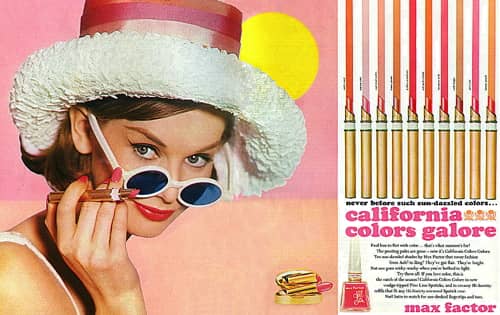
Above: 1963 Max Factor California Colors Galore! promotion in Fine Line Lipsticks and matching Nail Satin. Shades: Too Too Pink, Breezy Peach, Luminous Pink, Cafe Frappe, Golden Strawberry, Honey Pastel, Misty Coral, Not Quite Orange and Mad Mad Melon.
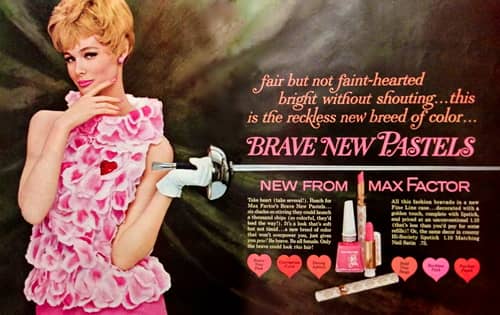
Above: 1964 Max Factor Brave New Pastels promotion in Hi-Society and Fine Line Lipsticks and matching Nail Satin Shades: Brave Pink, Daring Apricot, Reckless Pink, Courageous Coral, Bold New Beige, and Peerless Peach.
By 1964, Max Factor had at least 48 shades of lipstick in its shade range which included a number of iridescents.
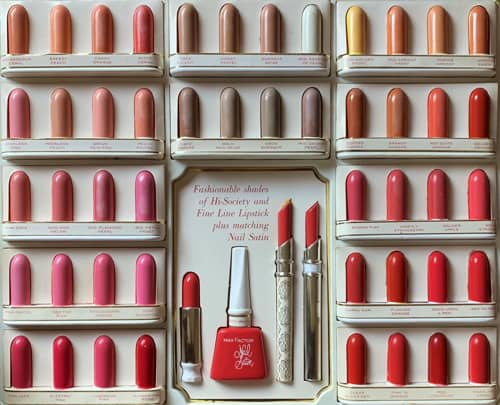
Above: 1964 Part of a Max Factor display case.
Things changed when Max Factor introduced its UltraLucent Creme Lipsticks in 1965. This lipstick came in a new case and was sold in 21 colours including 8 iridescents. Its arrival appears to have led to the depreciation of both Hi-Fi and Hi-Society lipsticks although each continued on for some time. For the remainder of the decade new shades were only advertised as available in UltraLucent or Fine Line lipsticks but not necessarily in both.

Above: 1965 Disco-Tints in UltraLucent Creme lipsticks and matching Nail Satin. Shades: Cocoa-Frost, and Touch-of-Pink.

Above: 1966 California Sun Glosses in UltraLucent Creme Iridescent Lipsticks and matching Nail Satin. Shades: Laguana Beach, Capistrano Pink and California Coral.
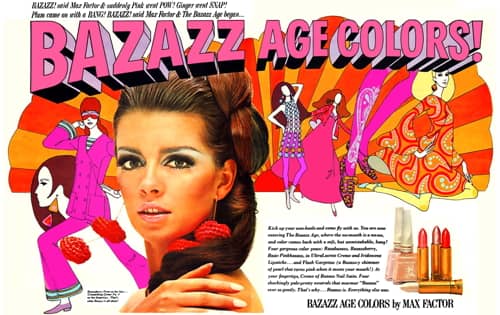
Above: 1966 Bazazz Age in UltraLucent Creme and Iridescent Lipsticks and Creme of Bazazz Nail Satin. Shades: Pinkbazzaz, Razabazzaz, Bazazzberry and Flash Gorgeous.

Above: 1967 The Sun Sheers in UltraLucent Creme Iridescent Lipsticks and matching Nail Satin. Shades: Sheer Pink, Sheer Berry, Sheer Blush, Sheer Honey, Sheer Coral and Sheer Peach.
Ultralucent lipsticks also underwent developments in the 1960s with the introduction of UltraLucent Cream Centre Lipsticks (1968), with a softer central core and a harder outer shell; and UltraLucent Whipped Creme Lipsticks (1970).
UltraLucent Cream Centre Lipsticks: “[A] creamy stick inside a lipstick to give your lips softer, moister, smoother, longer-lasting color.”
UltraLucent Whipped Creme Lipsticks: “[L]ipstick endowed with a million dollar shine! Slow-whipped with a wealth of moisturizers and rich concentrates to protect, pamper and shine your lips as never before. Twelve delicious new shades that won”t lick off, won”t kiss off.”
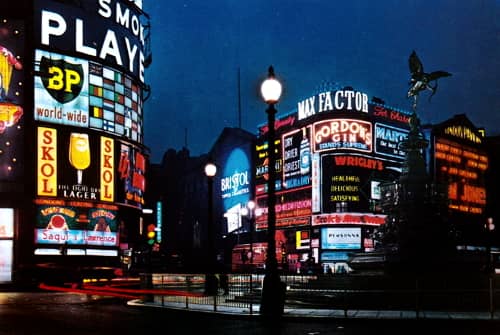
Above: Max Factor sign in Piccadilly Circus, London.
Men’s lines
The Signature range of men’s toiletries had been introduced by Max Factor in 1950 but by 1960 was largely advertised as Max Factor for Men.

Above: 1966 Max Factor Royal Regiment. Like other men’s toietries these were most heavily promoted before Father’s Day and Christmas.
During the rest of the decade the company added three more lines: Max Factor for Gentlemen (1964) which included an Aftershave Lotion, Deodorant Cologne, Gentlemen’s Cologne and Pre-electric Shave Lotion; Royal Regiment (1965) with an Aftershave Lotion, Cologne, Spray Cologne and Delux Soap, which added a lime fragrance in Cologne, Aftershave and Lanyard Shower Soap in 1967, and Sandalwood Cologne and Aftershave in 1971; and GTO (1967) which included a Cologne, Aftershave Lotion and Shaving Foam added as a promotional tie-in with the Pontiac GTO ‘muscle car’. This brought the number of Max Factor men’s lines to four, separated by packaging, fragrance and price.
Skin-care
Moisturisers were dominant skin-care theme of the 1960s. Max Factor had introduced its Active Moisturizer back in 1955 when it rolled out the Secret Key Treatment groups. In 1961, the company added two new moisturising products, Moisture Plus Cleansing Cream and Fresh Beauty Moisture Mask. Moisturising ingredients, humectants, were also incorporated into the Swedish Formula Hand Creme, also added in 1961.
Moisture Plus Cleansing Cream: “A scientific complex of cleaning agents that removes every trace of make-up and impurities plus moisturizers that refresh parched skin throughout the cleansing action.”
Fresh Beauty Moisture Mask: “[F]loods your face with precious moisture, removes impurities, smooths skin. This refreshing new mask ‘sets’ in ten minutes—comes off in one piece.”
Swedish Formula Hand Creme: “This rich new formulation combined with a stimulating 20 second massage works miracles on rough, red skin. With its penetrating softeners, beauty oils, healing agents, and humectants, Swedish Formula Hand Creme helps return natural beauty and softness to your hands.”
In 1968, Max Factor then developed its Moisture Essence set, an Under Make-up Lotion combined with a Night Cream.
Moisture Essence Under Make-up Lotion: “A very light-textured moisturizing lotion.”
Moisture Essence Night Cream: “A non-greasy, light-textured night cream. Rich in penetrating beauty oils. Helps return lost moisture to the skin.”
A number of these new lines were combined with older items in Max Factor skin-care routines such as this one for more mature skin.
Start off right in the morning, cleanse your face with Double Action Cleansing Cream. A unique cream and water cleanser that actually moisturises your skin while its deep penetrating action searches out every particle of grime and make-up. Its light refreshing touch cleanses without drying, leaves skin soft and supple. And no greasy feeling afterwards, it just rinses off with water.
Finish of with Secret Key. A gentle refreshing beauty tonic that tones and firms your skin, leaving it ready for make-up.
And because Secret Key’s special formula restores your skin’s natural balance, moisturising creams become more effective . . . make-up holds its colour longer.
The secret of a day-long dewy radiant look is Moisture Essence Under Make-Up Lotion. It works secretly, invisibly, to lock in the skin’s vital moisture to a degree previously possible only with heavier creams and lotions.
Now for the bedtime story. Cleanse away the grime with Double Action Cleansing Cream and tone with Secret Key. Your skin is now ready to receive Cup of Youth Night Cream. A feather-light, creamy white night cream that soothes and nourishes with a special combination of rare beauty oils, to bring back the smooth firm texture of young skin.
If your skin tends to be extra dry, you need the smoothing emollients and moisturisers in Velvety Night Cream. This is an exceptionally rich night cream that soaks into thirsty skins smoothing away lines, soothing away dryness.(Max Factor advertisement, 1969)
These Max Factor skin-care suggestions from Australia indicate that the company had also embraced the concept of combination skin by the end of the decade.
NORMAL SKIN
Cleanse: Cleansing Cold Cream. Double Depth Cleansing Cream or Facial Bath.
Tone: Skin Freshener or Secret Key.
Moisturise: Moisture Essence Under Make-up Lotion.
Nourish or Correct: Moisture Essence night cream or Dry skin Cream.DRY SKIN
Cleanse: Double Depth Cleansing Cream or Cleansing Cold Cream.
Tone: Secret Key or Skin Freshener.
Moisturise: Active Moisturiser.
Nourish or Correct: Cup of Youth or Velvety Night Cream.OILY SKIN
Cleanse: Cosmetic Soap or Facial Bath.
Tone: Astringent Lotion or Secret Key.
Moisturise: Astringent Foundation.
Nourish or Correct: Moisture Essence Night Cream.COMBINATION CREAM
Cleanse: Facial Bath.
Tone: Secret Key.
Moisturise: Astringent Foundation. Moisture Essence Under Make-up Lotion.
Nourish or Correct: Moisture Essence Night Cream.DISTURBED SKIN
Cleanse: Pure Magic Medicated Cleanser or Cosmetic Soap or Facial Bath.
Tone: Pure Magic Medicated Astringent or Secret Key.
Moisturise: Astringent Foundation.
Nourish or Correct: Clear-up or Pure Magic Medicated Cream.
(Max Factor advertisement (modified), 1969)
Moisture also featured prominently in UltraLucent makeup and Geminesse skin-care and make-up and was featured in ancillary products such as the Max Factor Swedish Formula Moisturizing Bath Oil introduced in 1971.
Swedish Formula Moisturizing Bath Oil: “It is concentrated with an abundance of pure, gentle moisturizers and penetrating emollients that make even the driest skin feel softer and smoother.”
In 1971, Max Factor would add a number of other Swedish Formula products for the face, marketing the group as fragrance free and hypoallergenic.
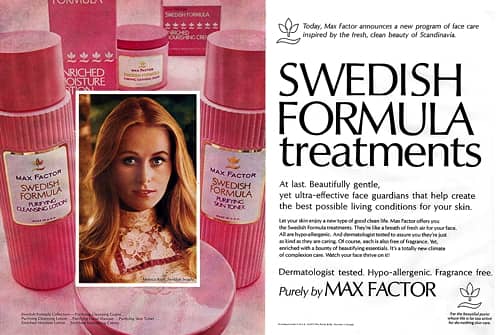
Above: 1971 Swedish Formula treatments for the face. The treatments included Swedish Formula Purifying Cleansing Grains, Purifying Cleansing Lotion, Purifying Facial Masque, Purifying Skin Toner, Enriched Moisture Lotion and Enriched Nourishing Creme.
Eye make-up
In the 1960s the focus of the face moved from the lips to the eyes and, responding to this trend, Max Factor added a number of new eye make-up lines starting, in 1961, with Hi-Fi Powder Eye Shadow in seven shades. Unlike later powdered eye shadows, this product was not a pressed powder but rather, was a loose powder applied with special applicator. A more conventional compressed powder eye shadow was introduced with Shadow Play Brush Eye Shadow in 1965.
Other forms of eye make-up introduced by Max Factor during the 1960s included: Lash-Full Textured Mascara Wand, a lash-lengthener and mascara in one (1963); Self Sharpening Automatic Eye Pencil, and Brush & Brow Eyebrow Make-up (1964); Brush-Tip Mascara Wand, which used a brush rather than a grooved metal rod (1965); Shadow Creme, another compressed powder (1966); Shiney Eye-Liner (1967); and Water Power Eye Shadow which required water to mix up the shadow (1969).
Hi-Fi Powder Eye Shadow: “Blends perfectly, never smears, smudges or cakes” Shades: Blue, Blue Mist, Green, Green Mist, Blue Green, Lilac Green and Lime-Mist.
Brush & Brow Eyebrow Make-up “The softest most natural looking brows—ever—with never a hint of the penciled, the stenciled, the harsh.” Shades: Soft Black, Midnight Brown, Natural Brown, Ash Blonde, and Smoky Gray.
Shiney Eye-Liner: “Flows on perfectly with its own sable brush – stays shiny even after it dries – peels off gently.” Shades: Shiny Black, Shiny Brownish-Black, Shiny Brown, Shiny Gray-Black, Shiny Navy Blue, and Shiny White.
Like lipsticks, eye make-up became a regular part of Max Factor promotions in the 1960s. Some of these combined shades of compressed powder eyeshadow into palettes with or without other forms of make-up.
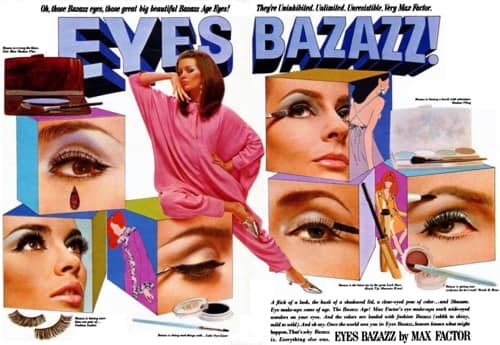
Above: 1966 Max Factor Eyes Bazazz, part of the Bazazz Age promotion.
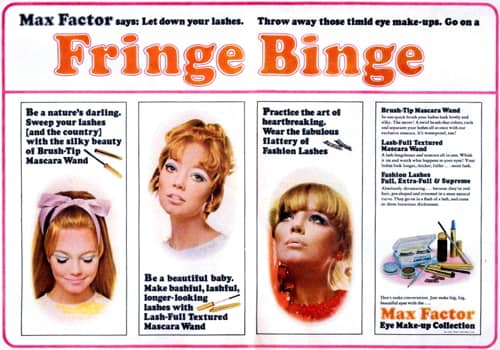
Above: 1967 Max Factor Finge Binge promotion.
Max Factor also added new ranges of false eyelashes. The company had been making these for years but now that they were highly fashionable added a number of new forms including: Fashion Lash Artificial Lashes (1965) in Full, Extra Full and Supreme with Demure Lash, Romantic Lash, Sophisticated Lash, Demi-lash, Subtle Lash, Duo-tone Lash, Natural Lash, and Glamourlash styles added in 1968 in Natural, Black or Brown. 1969 Lash-A-Dashery and Peak-A-Boo Lashes kits which combined fasle eyelashes with other forms of make-up were added in 1969.

Above: 1969 Max Factor Lash-a-Dashery kit.
As with lipsticks, new forms of eye make-up were also added to the Pure Magic, UltraLucent and Geminesse lines.
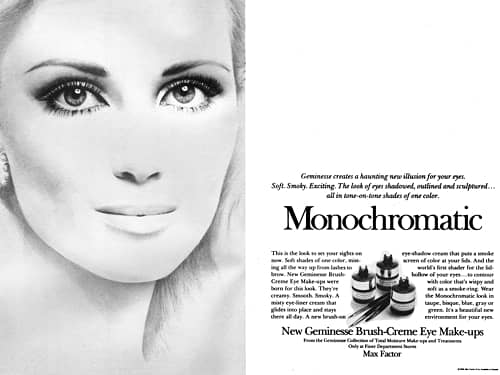
Above: 1969 Geminesse Brush-Creme Eye Make-up in tone-on-tone shades of one colour.
UltraLucent
Max Factor had developed translucent make-up in the past, notably Translucent Creme Puff and Translucent Face Powder (1959) as well as Finishing Powder (1961). In 1965, Max Factor then introduced a new ‘ultra-sheer’ make-up line called UltraLucent, the first products in the line being UltraLucent Fluid Make-Up, UltraLucent Face Powder and UltraLucent Creme Lipstick.
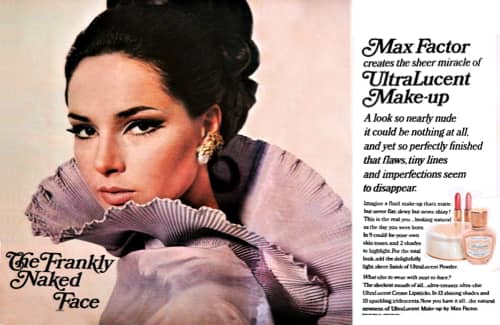
Above: 1965 UltraLucent Fluid Make-Up, UltraLucent Face Powder and UltraLucent Creme Lipstick.
UltraLucent Fluid Make-Up: “[A] transparent veil so incredibly light it could be nothing at all . . . and yet, so delicately balanced that flaws melt away, color seems to spring from within. UltraLucent works with your own skin tone to create a completely natural glow . . . dewy but not shiny, matt but not flat.”
UltraLucent Creme Lipstick: “A lipstick that knows no dryness. … Incredibly creamy new color base that’s pure gloss (yet soft and un-greasy).”
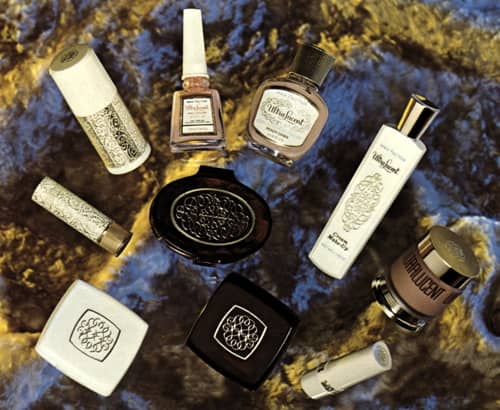
Above: 1969 Max Factor UltraLucent.
Max Factor then built Ultralucent into a complete make-up line adding items such as: UltraLucent Highlights, UltraLucent Pressed Powder and UltraLucent Creme Iridescent Lipsticks (1966); UltraLucent Counter-Shine and Ultralucent Cream Make-up (1967); UltraLucent Blusher, UltraLucent Counter-Shine Brush-On Pressed Powder and UltraLucent Nail Color (1968); UltraLucent Blusher Stick, Ultralucent Baby Blusher, UltraLucent Whipped Creme Make-Up, UltraLucent Whisper Tint and UltraLucent Cream Center Lipsticks (1969); UltraLucent Whipped Cream Lipsticks and UltraLucent Face Glazers (1970); and UltraLucent Waterproof Make-up (1971).
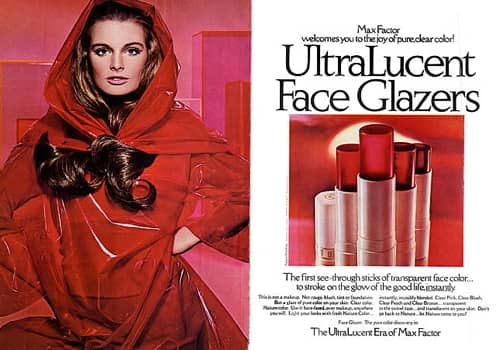
Above: 1970 Max Factor UltraLucent Face Glazers. Shades: Clear Pink, Clear Blush, Clear Peach and Clear Bronze.
Although originally conceived only as a make-up line, skin-care products were added to UltraLucent after the company was sold to Norton Simon in 1973.
Geminesse
One of the problems for Max Factor, that was going to get even more serious in the 1970s, was margins. Max Factor did well in lower-priced markets but margins there were low, and the company was coming under increasing pressure at the upper end where its margins were better. If higher-margin products suffered, profits would decline, even though sales remained relatively steady. Revlon encountered a similar problem as its competition with Estée Lauder got more serious and countered by developing the Princess Marcella Borghese line in 1957.
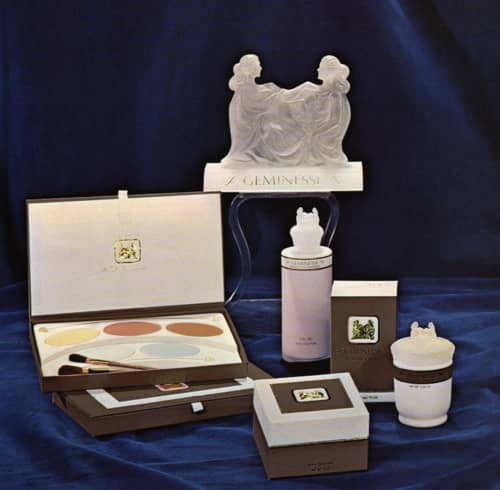
Above: 1966 Geminesse. Described as a “distinguished line of luxurious products for the woman who believes in a beauty investment in herself” it was available in selected department stores where it was sold by uniformed clerks.
In 1966, Max Factor tried the same strategy and introduced an up-market line called Geminesse. As well being packaged in ornate containers the line was only sold through selected department stores to give it a degree of exclusivity. Initial products in the line included both skin-care and make-up. The skin-care range stressed moisturisation as the key to a younger-looking face.
Geminesse: “The first complete beauty collection created from the concept of Total Moisture to prevent moisture loss, restore lubricating power to exhausted cells. It’s more than a superb new skin care; it goes beyond all luxury make-ups . . . Geminesse imparts the secret of the Eternally Younger Face.”
Geminesse Beauty Cream: “[A] rich sheltering night cream that’s steeped in nourishing moisturizers.”
Geminesse Beauty Cleanser: “[G]ives your skin a thorough, infinitely gentle cleansing.”
Geminesse Toning Lotion: “[R]efines and freshens with non-drying stimulation.”
Geminesse Moisturizer: “[A] gossamer guardian angel against your skin’s moisture loss creates a silken surface for Geminese make-up.”
Make-up in the initial range included Geminesse Fluid Make-up, Geminesse Contour Supreme, Geminesse Finishing Powder Geminesse Powder Compact. It was light reflective and included highlighters and shadows to contour the face, an idea that Max Factor had helped originate back in the 1930s.
Geminesse make-up creates beauty illusions of highlights, contour and shadow. Max Factor creates the new cosmetic art . . . you create the illusion of the Eternally Young Face.
Geminesse Fluid Make-up: “[F]or an ultra-sheer foundation. A delicate balance of light and mosturized color. Nine highly personalized shades . . . one is perfect for you.”
Geminesse Contour Supreme: “[a] trio of subtle highlights and shadows, with an outliner and fill-in brush.”
Geminesse Finishing Powder: “[A] fine light reflective powder.”
Geminesse Powder Extravaganza: “Delight in five light-reflective pressed powder.”
One way the company promoted the range was as a two phase system, phase 1 skin-care, phase 2 make-up.
phase 1 . . . A unique 3 step plan for complexion care called “total moisture.” Beauty Cleanser removes every harmful trace of makeup and dirt. The Beauty Cream and Moistur izer protect and replenish your skin with special oils and emollients. Finally, the Toning Lotion helps you to achieve a fine-grained skin texture.
phase 2 . . . Geminesse makeup lets you re-define the shape of your face . . . accent your loveliest features with sheer fluid makeup and an array of highlighting blush-ons and powder. Come in and select the Geminesse preparations just for you.(Max Factor advertisment, 1966)
Later in the year Max Factor added Geminesse Lipsticks in 22 shades which could be bought in a new ‘nugget’ case with matching pressed powder compact.
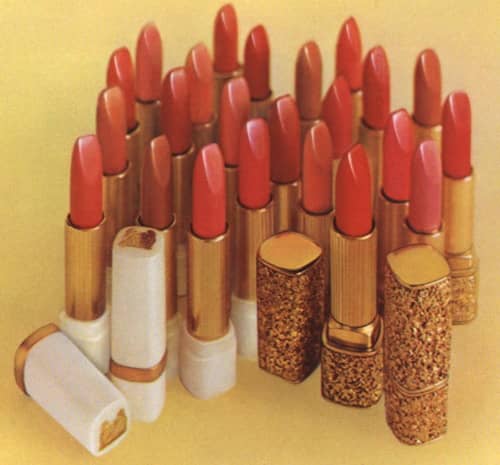
Above: 1966 Max Factor Geminesse Lipsticks in white and nugget cases.
A Geminesse Lip Accent Stick was added in 1968 to help woman contour their lips.
Geminesse Lipsticks: “[E]xquisite, extravagant, silky rich, moisture-laden. Each color glides on the lips with creamy luxury, and such eolors . . . well-bred reds, cool proud corals, high-born pinks, best-dressed beiges. Scintillating hues, shimmering iridescents . . . lipstick a lady can glow in, in a case that’s worthy of the product and the owner.“
Geminesse Lip Accent Stick; “[Gives] a woman all the benefits of an accent color without any of the draw-backs of a double lipstick application. Created for the express purpose of accenting lip contours, its lightweight formula adds no heavy look to beautiful mouths, only the sheer flattery of moist and dewy color high lights.”
In 1967 Max Factor added Geminesse Flowing Cream Make-up, Geminesse Blush Powder, Geminesse Blush Cream and a complete line of Geminesse Make-up for the Eyes – Brow Make-lip, Shadow Cream, Shadow Powder, Cover-up Cream, Liquid Liner, Cake Mascara, Eye Make-Up Fixative and Cake Liner. In 1969, it then added five new skin-care products in its Geminesse Facial Fitness range – Exhilarating Skin Lotion, Stimulating Cleanser, Enriched Night Concentrate Cream, Facial Firm-Up and Thermal Moisturizing Facial.
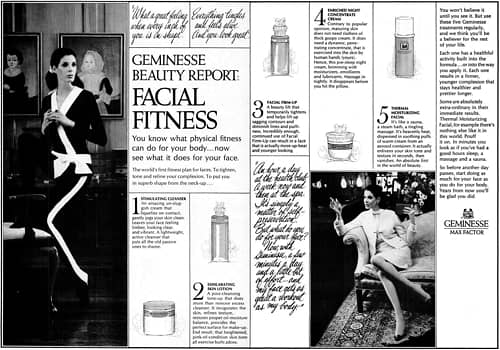
Above: 1969 Max Factor Geminesse Facial Fitness: Stimulating Cleanser, Exhilarating Skin Lotion, Facial Firm-Up, Enriched Night Concentrate Cream and Thermal Moisturizing Facial.
Exhilarating Skin Lotion: “An all-in-one moisturizing akin conditioner and toning lotion with a tingling action that refreshes skin.“
Stimulating Cleanser: “A formula that generates inner and outer cleansing as it wakes up skin tone.“
Enriched Night Concentrate: “A scientifically formulated exercise cream that nurtures rough dry skin to a youthful softness and smoothness.“
Facial Firm-Up: “A liquid isometric exercise for the face and throat. Helps lift up an overweight chin and firm up sagging.“
Thermal Moisturizing Facial: “The first instant heat cream facial. Gives a bright and smoother complexion.“
Additional products were added later and the range did reasonable business until it was neglected in the 1970s.
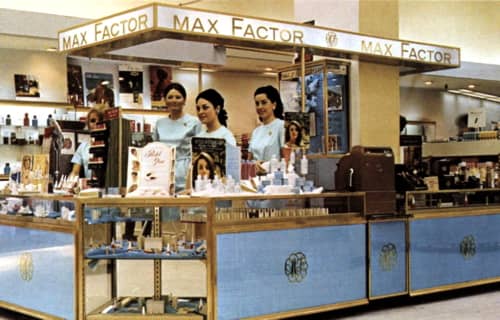
Above: 1966 Max Factor counter at Galleries-Lafayette, Paris.
Corporate acquisition
In 1967, Max Factor made its second acquisition for the decade, purchasing the Denver Manufacturing Company. Located in Stamford, Connecticut, Denver made medical and dental pharmaceuticals as well as diagnostic products under the name Wampole Laboratories which were sold both in the United States and Internationally. Denver had made a profit of US$620,074 in 1966 but, more importantly, it reduced Max Factor’s reliance on cosmetics.
In 1964, Max Factor looked at merging with American Cyanamid but the negotiations floundered. After a number of the extended Factor family left the business, Alfred Firestein [1924-1973], Max Factor’s grandson, became the president of the company in 1968 but he died a few months after Max Factor was merged with Norton Simon, Inc. for about US$480 million in stock in 1972. After Alfred’s death, Chester Lee Firestein [b.1930] took over as president of Max Factor in 1973 but he resigned in 1976 for personal reasons. Max Factor, Jr. also retired and this meant that there were no immediate family members left in the business.
Sam Kalish, a Revlon executive, was then hired to take over the Max Factor division. By the time he arrived profit margins had eroded and earnings had declined by US$20 million (Allen, 1981, p. 105). Unfortunately, his new Maxi line did not go well and he left the company within two years. Further management problems followed.
In 1983, Norton Simon was acquired by Esmark which then merged with Beatrice Foods in 1984. Max Factor was put into the Playtex beauty division of Beatrice Foods and its headquarters were moved from Los Angeles to Stamford, Connecticut, resulting in the building in North Highland Avenue being closed. Then, in 1986, Kohlberg, Kravis, Roberts & Company acquired the Beatrice companies and sold the Playtex division to an investor group lead by Joel E. Smilow (b.1933). To help fund the acquisition of Playtex, Smilow sold the Esmark cosmetic brands, Max Factor, Almay and Halston, to Revlon who then moved the Max Factor company headquarters back to the Max Factor building in Los Angeles. When Max Factor was sold to Procter & Gamble for more than US$1 billion in 1991 the headquarters were again moved, this time to Cincinnati.
In 2001, Procter & Gamble discontinued sales of Max Factor in the America due to poor returns and concentrated on promoting Cover Girl instead – a brand they had bought in 1988 when they acquired Noxell. In 2016, Coty bought Max Factor and Cover Girl from Procter & Gamble. Time will tell if this leads to a lasting revival of the Max Factor brand in the United States.
Timeline
| 1960 | New Products: Hand and Body Smoothing Lotion; and Sheer Genius make-up. |
| 1961 | Max Factor & Company goes public. Max Factor acquires Parfums Corday, Inc. and Parfumerie Internationale Corday. New distribution centre opens in Des Plaines, Illinois near the O’Hare International Airport, Chicago. New Products: Fresh Beauty Moisture Mask; Swedish Formula Hand Cream; Sheer Genius Extra Cover; Finishing Powder; and Nail Satin Nail Polish, Base Coat, Top Coat and Matt Base. |
| 1962 | New Factory completed in Guatemala City, Guatemala. New Products: Fine line lipsticks; Pure Magic Medicated Cake Make-up; and Pure Magic Medicated Compact Make-up. |
| 1963 | New Factory completed in Toronto, Canada. Branch opened in San Juan, Puerto Rico. New Products: Pure Magic Medicated Liquid Make-up; Golden Woods bath line; California Bronze, a suntan lotion; Pastel Tints Rouge; and Lash-Full Textured Mascara Wand. |
| 1964 | Regional office opened in 21st floor of the Bankers Trust Building at 280 Park Avenue, New York. New Products: Brush & Brow Eyebrow Make-up; Pastel Glow, brush-on face toner; Touch of Youth Wrinkle Smoothing Lotion; Max Factor for Gentlemen; Self-Sharpening Automatic Eye Pencil; and Max Factor Regency Thin-Line Compacts. |
| 1965 | New distribution centre opened in Gardena, California. New Products: UltraLucent Fluid Make-up Face Powder and Creme Lipstick; Coiffure Italienne Color Highlight Shampoo; Lip Frosting, highlight and accent for lipsticks; Brush-Tip Mascara Wand; Fashion Lash, false eyelashes; Shadow Play Brush Eye Shadow; Erace Plus; and Royal Regiment men’s line. |
| 1966 | New Max Factor building at 6922 Hollywood Boulevard. New Products: UltraLucent Highlights; UltraLucent Pressed Powder; UltraLucent Creme Iridescent Lipsticks; Geminesse skin-care and make-up range; Geminesse Lipsticks; Shadow Creme; and Positive Protection Formula Antiperspirant. |
| 1967 | New Branch opened in El Salvador. New Products: Shiny Eye Liner; UltraLucent Counter-Shine; UltraLucent Creme Make-up; Geminesse Flowing Cream Make-up; Geminesse Blush Powder; Geminesse Blush Cream; Geminesse Make-up for the Eyes; Tried & True Shampoo-In Permanent Hair Color; and GTO men’s line. |
| 1968 | Max Factor acquires the Denver Chemical Manufacturing Company. New Products: Erace White; Geminesse Lip Accent Stick; UltraLucent Blusher; UltraLucent Counter-Shine Brush-On Pressed Powder; and UltraLucent Nail Color. |
| 1969 | New Products: Exhilarating Skin Lotion; Stimulating Cleanser; Enriched Night Concentrate; Facial Firm-Up; Thermal Moisturizing Facial; UltraLucent Blusher Stick; Ultralucent Baby Blusher; UltraLucent Whipped Creme Make-Up; UltraLucent Whisper Tint; UltraLucent Cream Center Lipsticks; and Water Power Eye Shadow. |
| 1970 | New Branch opened in Indonesia. New Products: UltraLucent Whipped Cream Lipsticks; UltraLucent Face Glazers; Pan-Stik Plus; and Pastel Touch. |
| 1971 | New Products: UltraLucent Waterproof Make-up. |
| 1972 | Max Factor merged with Norton Simon, Inc. |
| 1973 | Max Factor Hair Department closed down. |
| 1975 | New Products: Halston line of fragrances. |
| 1976 | President Chester Lee Firestein and Max Factor, Jr. resign. |
| 1980 | Max Factor adds the cosmetics business of Smith & Nephew Associated Companies, London (Mary Quant, Outdoor Girl and Miners). |
| 1983 | Norton Simon (includes Max Factor) acquired by Esmark. |
| 1984 | Esmark merges with Beatrice Foods. Max Factor put into the Playtex beauty division. |
| 1986 | Revlon, Inc. acquires Esmark’s Playtex beauty division (includes Max Factor). |
| 1991 | Max Factor and Betrix GmbH acquired by Procter & Gamble from Revlon. |
| 2001 | Procter & Gamble discontinues sales of Max Factor in the U.S. |
| 2016 | Max Factor acquired by Coty. |
First Posted: 19th August 2013
Last Update: 14th April 2023
Sources
75 years of Max Factor. (1984). Manufacturing Chemist. January, 49.
Allen, M. (1981). Selling dreams. Inside the beauty business. London: J. M. Dent & Sons Ltd.
Basten, F. E. (1995). Max Factor’s Hollywood. Glamour, movies, make-up. Los Angeles: General Publishing Group.
Basten, F. E. (2008). Max Factor: The man who changed the faces of the world. New York: Arcade Publishing.
Max Factor & Co. Annual Reports 1947-1971.
The new art of make-up [Booklet]. (1948). Sydney: Max Factor Studios.
The new art of make-up [Booklet]. (1950). USA: Max Factor Hollywood.
Peiss, K. (2007). Hope in a jar: The making of America’s beauty culture. New York: Henry Holt and Company.
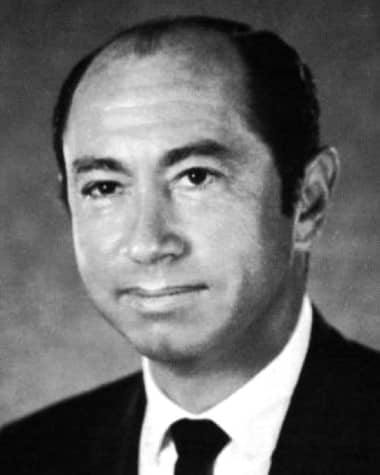
Alfred J. Firestein [1924-1973] Max Factor’s grandson. He became the president of the company in 1968.
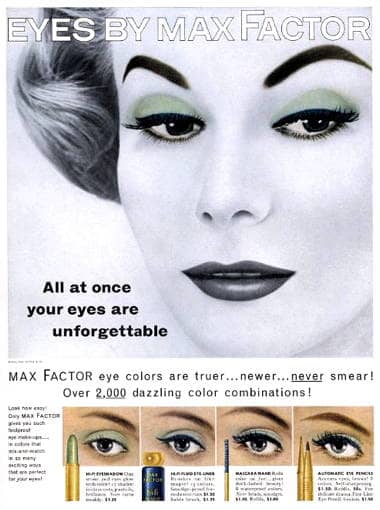
1960 Max Factor eye make-up including Hi-Fi Eyeshadow, applied like a lipstick, Hi-Fi Fluid Eye Liner, Automatic Mascara Wand and Automatic Eye Pencil.
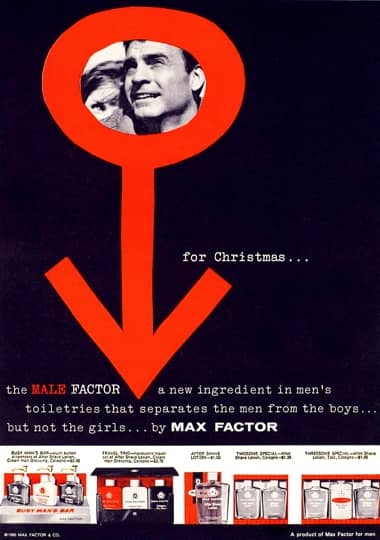
1960 Max Factor for Men.
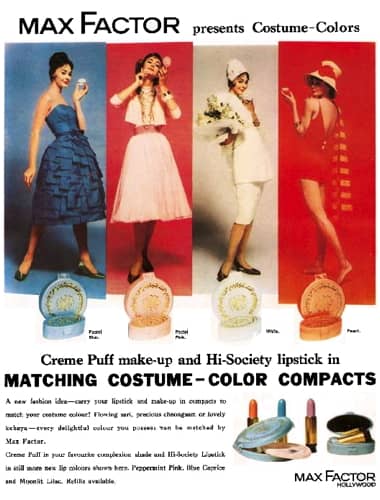
1960 Max Factor matching Creme Puff and Hi-Society cases coordinated with costume colours.
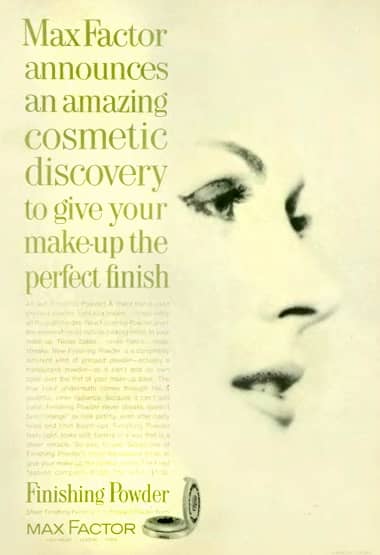
1961 Max Factor Finishing Powder.
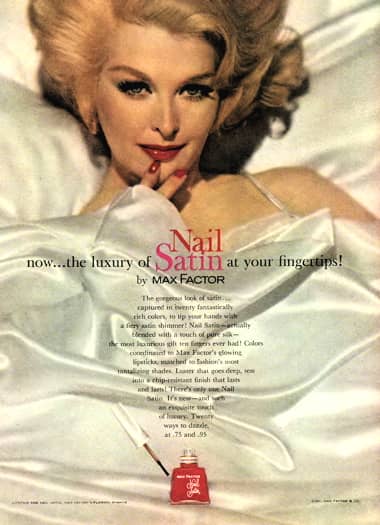
1961 Max Factor Nail Satin Nail Enamel in twenty shades.
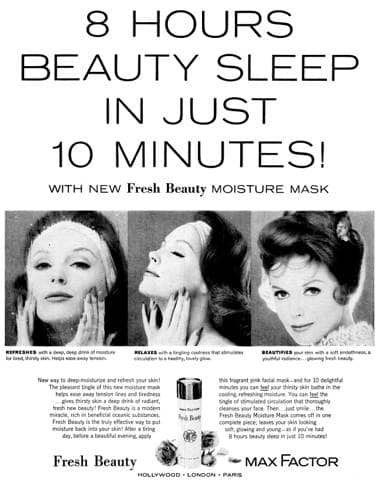
1961 Max Factor Fresh Beauty Moisture Mask.
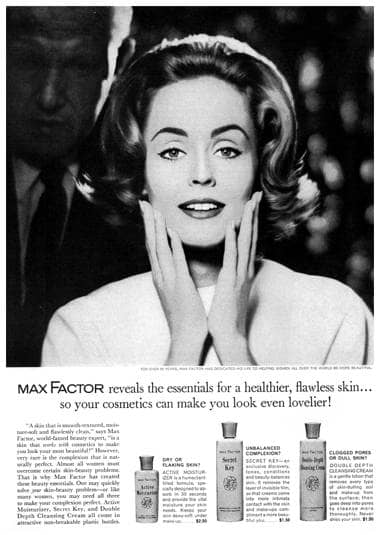
1961 Max Factor skin-care products. The products listed from left to right are Active Moisturizer, Secret Key and Double Depth Cleansing Cream.
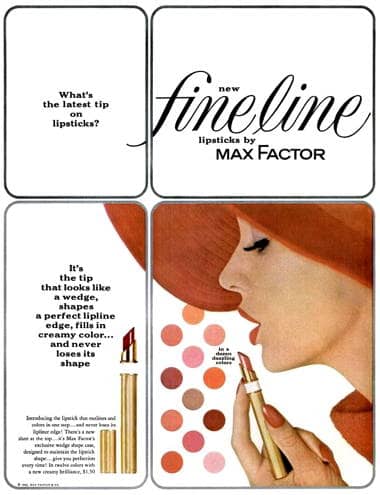
1962 Max Factor Fine Line Lipstick.

1962 Max Factor Fashion Matte Nail Satin.
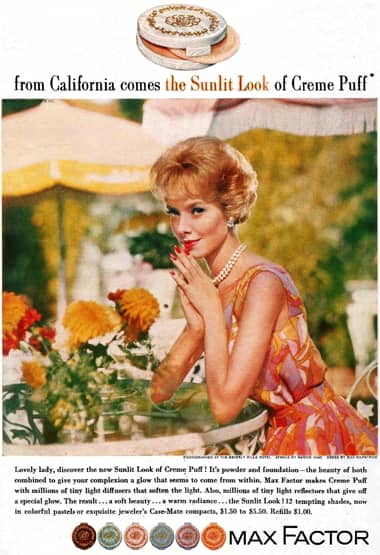
1962 Max Factor ‘The Sunlit Look’ Creme Puff cases.

1962 Max Factor Sheer Genius Natural Finish and Extra Cover.

1962 Max Factor Pan-Cake Make-Up.
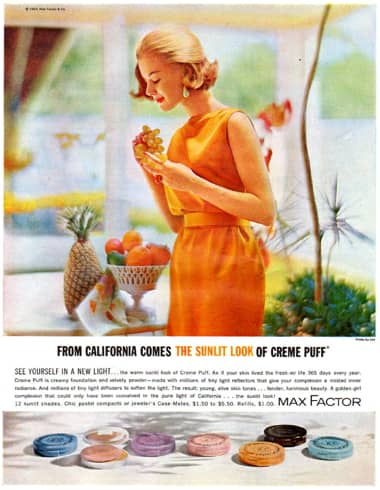
1962 Max Factor Creme Puff.
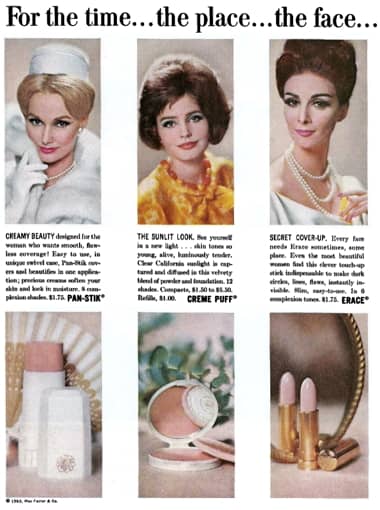
1963 Max Factor Pan-Stik, Creme Puff and Erace.
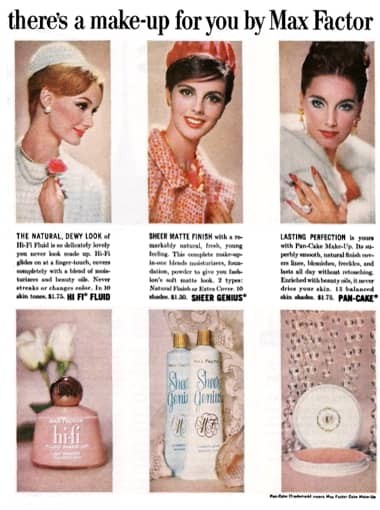
1963 Max Factor Hi-Fi, Sheer Genius and Pan Cake.
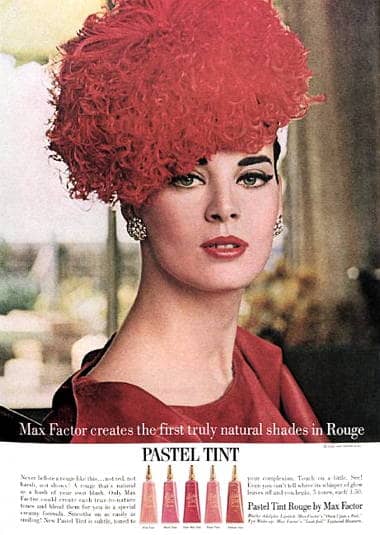
1963 Max Factor Pastel Tint Rouge. These were made using the Sheer Genius formula as a base.

1963 Max Factor Pure Magic.
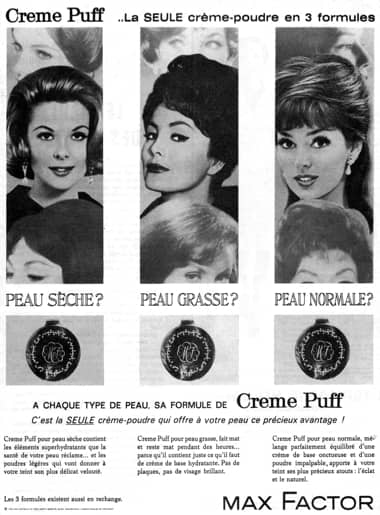
1963 Max Factor Creme Puff blends for dry, oily and normal skin types (France).
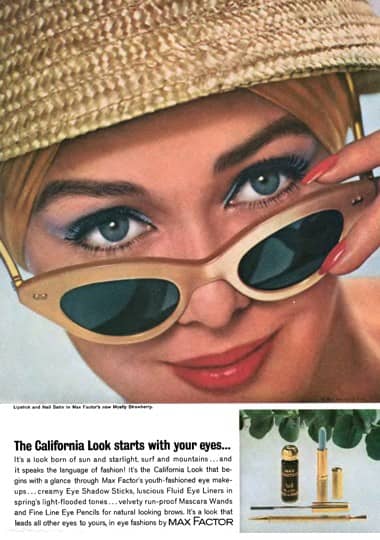
1963 Max Factor Californian Look eye make-up.
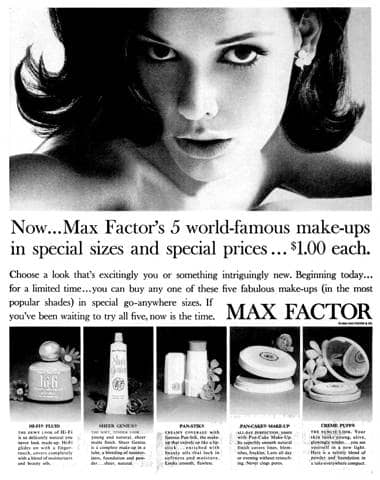
1964 Five forms of Max Factor make-up. Hi-Fi Fluid, Sheer Genius, Pan-Stik, Pan-Cake and Cream Puff. “Hi-Fi Fluid for the dewy look … Creme-Puff for the sunlit look … Sheer Genius for the soft tender look … Pan-Cake for all day perfection … Pan-Stik for creamy coverage”.

1964 Max Factor Pastels available as a Fine Line Lipstick, Hi-Fi Lipstick and Matching Nail Satin Nail Enamel in Brave New Pink, Courageous Coral, Daring Apricot, Bold New Beige, Reckless Pink, Peerless Peach shades.
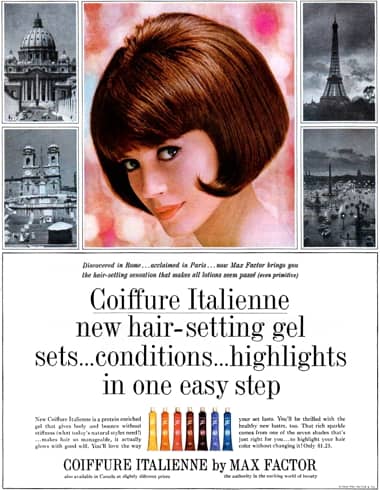
1964 Max Factor Coiffure Italienne.
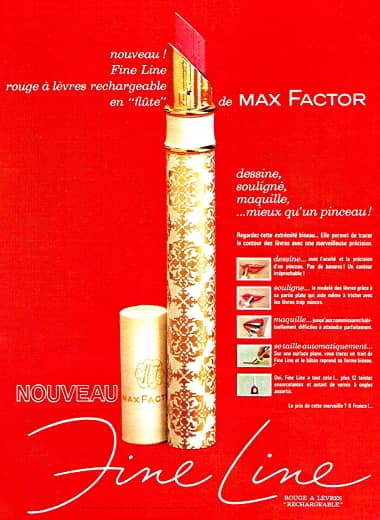
1964 Max Factor Fine Line Lipstick in new case.
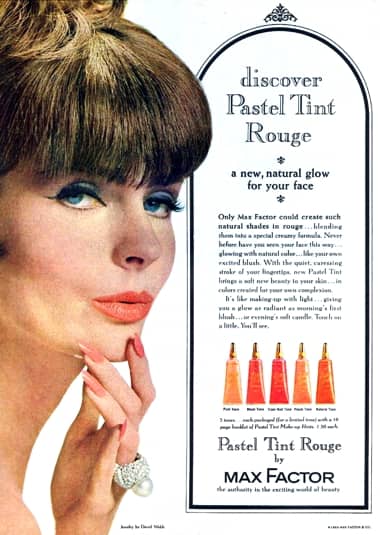
1964 Max Factor Pastel Tint, a cream rouge in Pink tone, Blush Tone, Clear Red tone, Peach Tone and Natural tone shades.
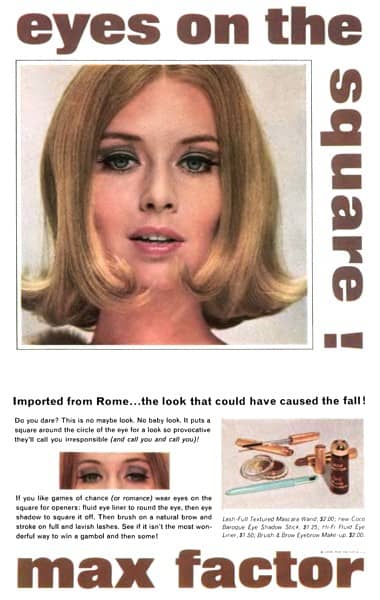
1964 Max Factor Eye Make-Up.
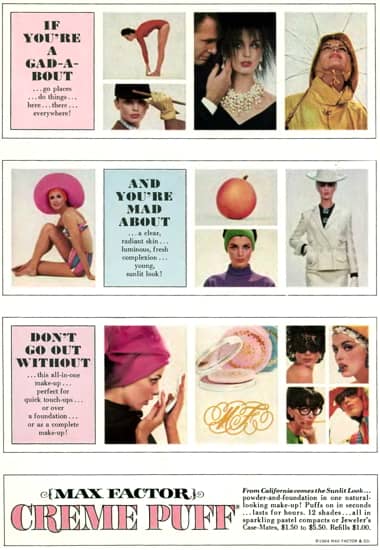
1964 Max Factor Creme Puff.
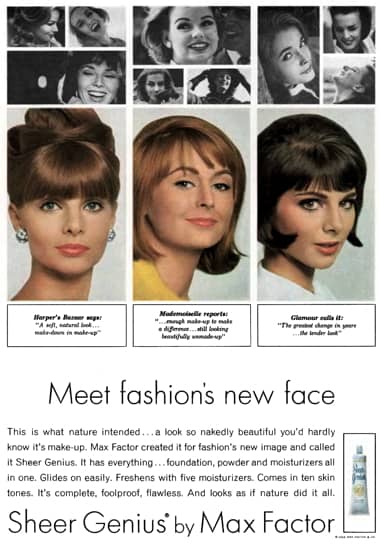
1964 Max Factor Sheer Genius.
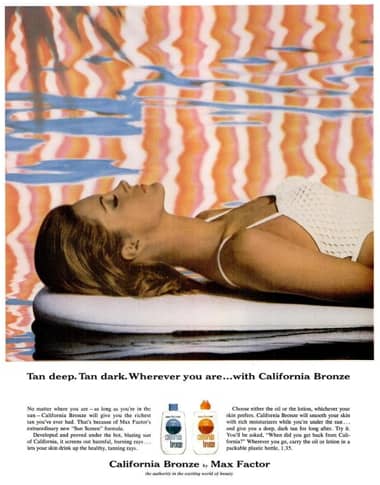
1964 Max Factor California Bronze.
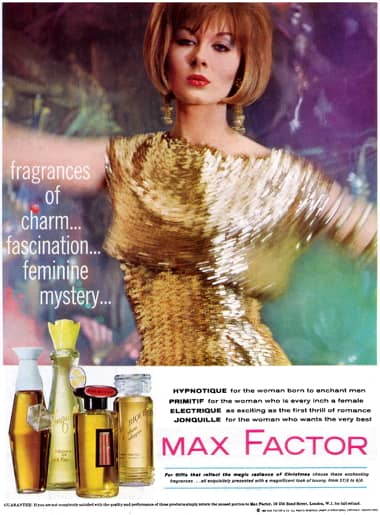
1964 Max Factor fragrances: Hypnotique (1958), Primitif (1956), Eletríque (1954) and Jonquille (1963).
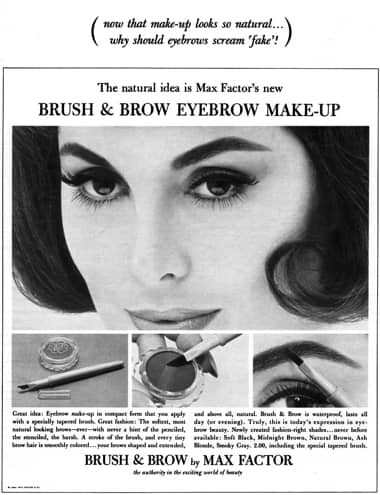
1964 Max Factor Brush & Brow Eyebrow Make-up.
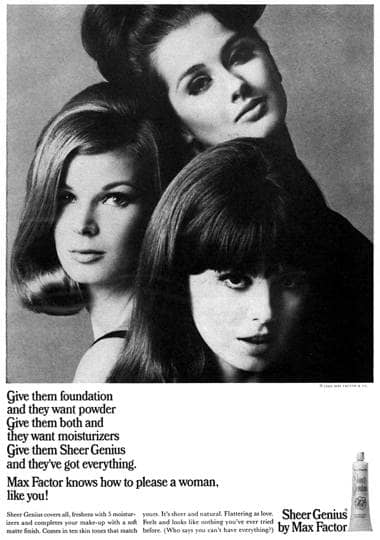
1965 Max Factor Sheer Genius.

1965 Max Factor ‘3 Little Bares’ promotion in Hi-Society Lipsticks and Nail Satin nail polish. Shades: Papaya Bare, Baby Bare and Mocha Bare.
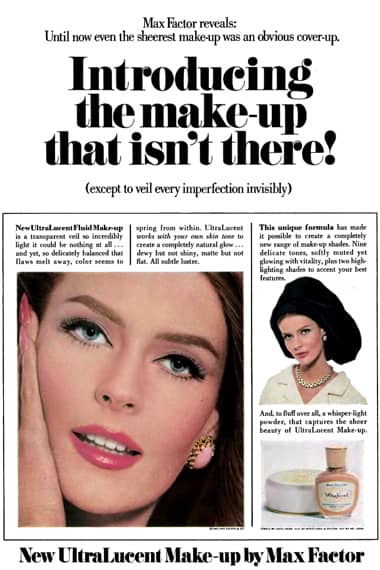
1965 Max Factor UltraLucent Make-Up.
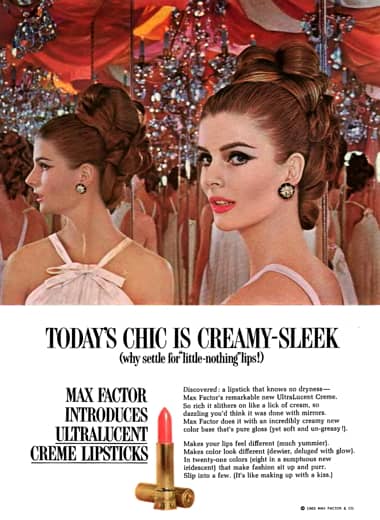
1965 Max Factor UltraLucent Creme Lipsticks.
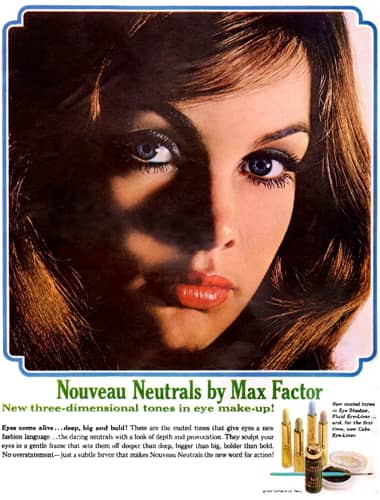
1965 Max Factor Nouveau Neutrals.

1965 Max Factor Haute Colour.
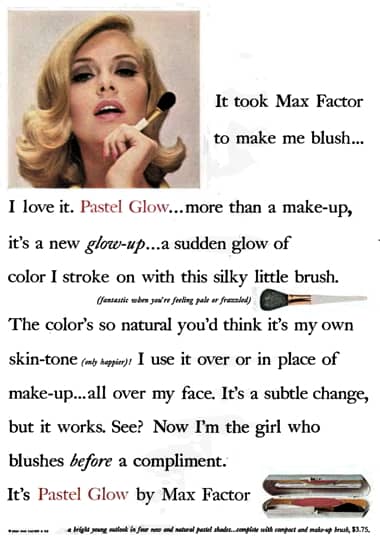
1965 Max Factor Pastel Glow.
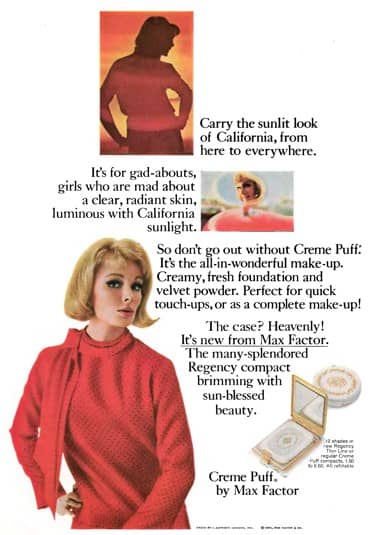
1965 Max Factor Creme Puff.
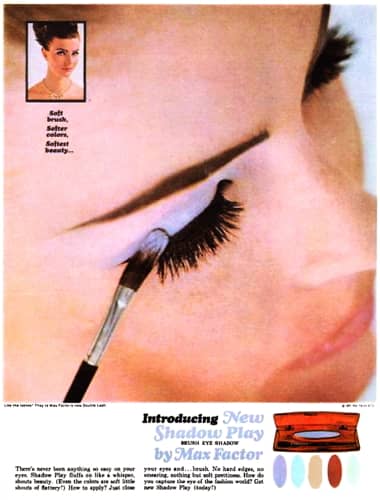
1965 Max Factor Shadow Play Brush Eye Shadow.

1965 Max Factor ‘Honey is Spring’ promotion. Honey Coral, Natural Honey and Sweet hHoney shades in Fine Line and Hi-Society Lipsticks with matching shades of Nail Satin nail polish.
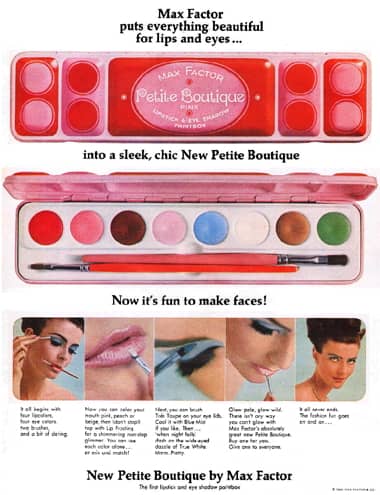
1965 Max Factor Petite Boutique. One of a number of cosmetic paint boxes introduced by cosmetic companies in the 1960s.

1966 Max Factor Shadow Creme Eyeshadow.
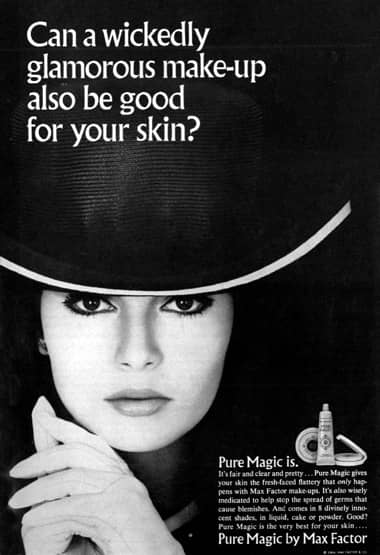
1966 Max Factor Pure Magic.
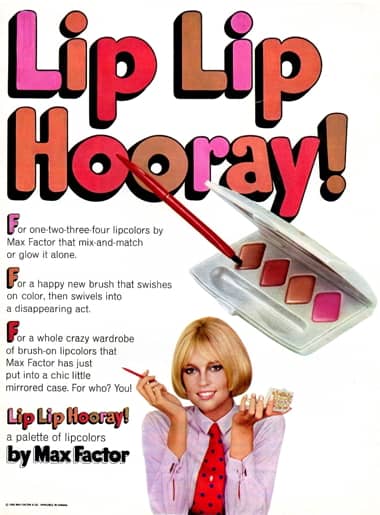
1966 Max Factor ‘Lip Lip Hooray’ promotion for lipstick colours applied with a brush from a palette.
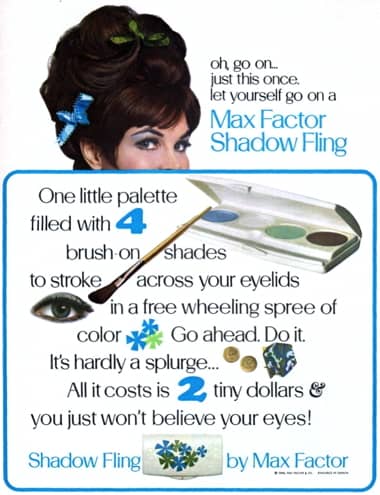
1966 Max Factor Shadow Fling.
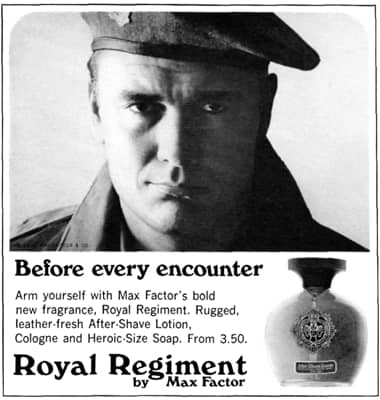
1966 Max Factor Royal Regiment After-Shave Lotion, Cologne and Soap.
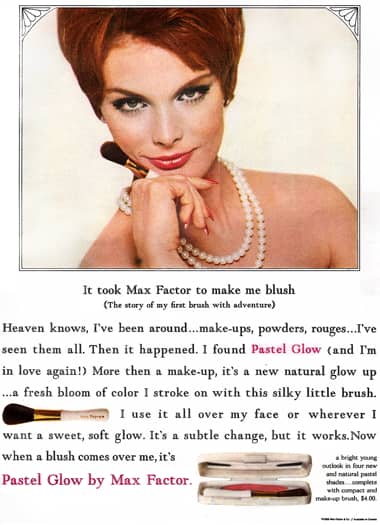
1966 Max Factor Pastel Glow.
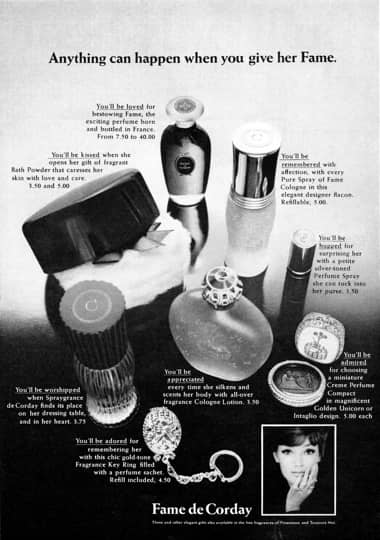
1967 Fame from Parfums Corday, now a subsidiary of Max Factor.
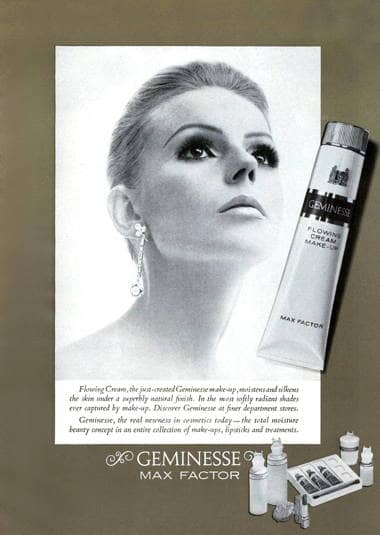
1967 Max Factor Geminesse Make-Up.

1967 Max Factor LipSlicks in Natural, Pink, Pearly White, and Pearly Peach shades..
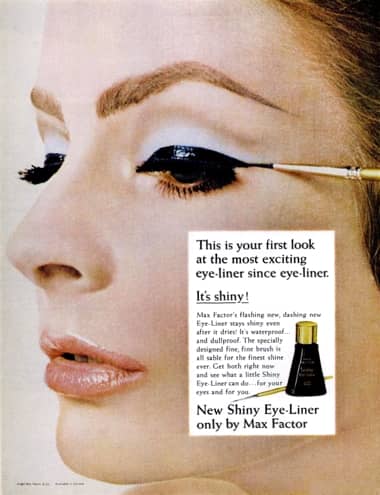
1967 Max Factor Shiny Eyeliner.
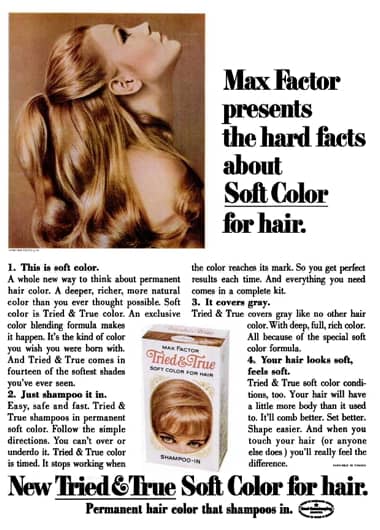
1967 Max Factor Tried & True Soft Color for hair.
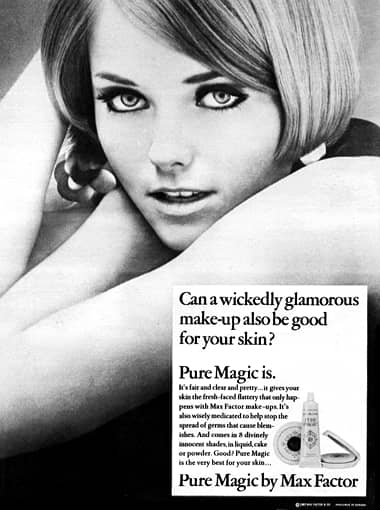
1967 Max Factor Pure Magic Medicated Cake, Compact and Liquid Make-up.
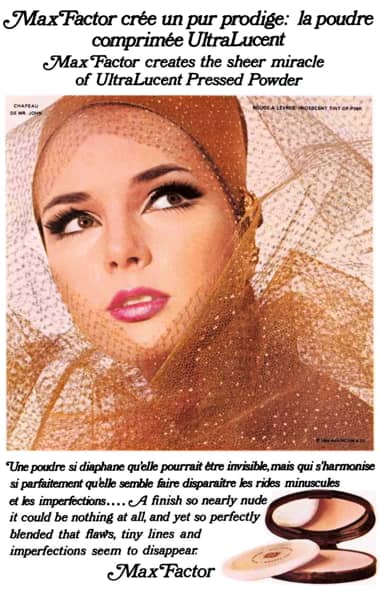
1967 Max Factor UltraLucent (France).
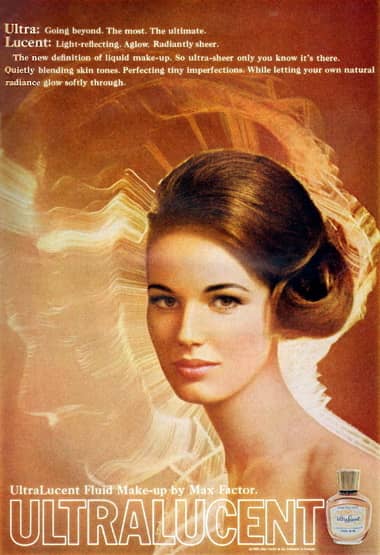
1968 Max Factor UltraLucent Fluid Make-Up.

1968 Max Factor GTO cologne for men.
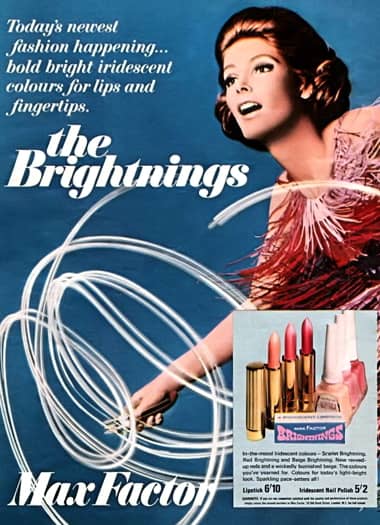
1968 Max Factor Brightnings. Iridescent Lipsticks and Nail Satin in Scarlet Brightning, Red Brightning and Beige Brightning shades.
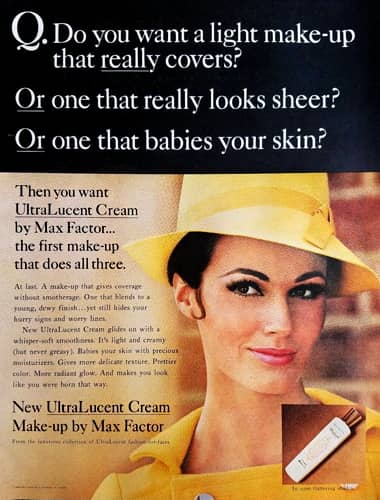
1968 Max Factor UltraLucent Cream Make-Up.
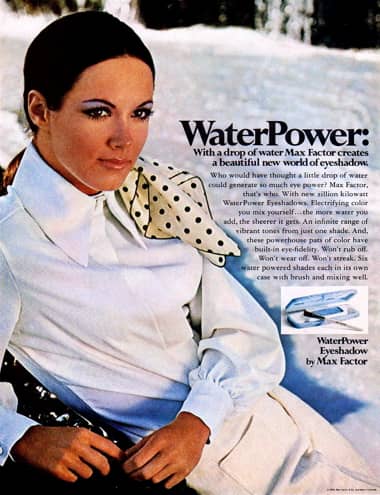
1969 Max Factor Waterpower Eyeshadow.
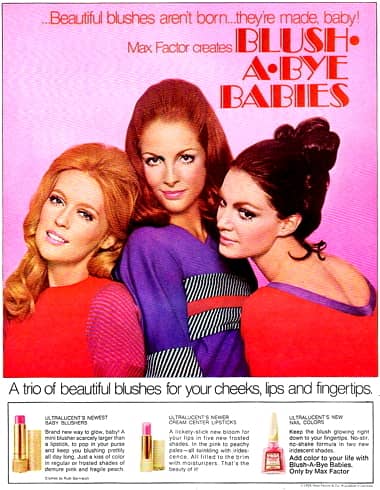
1969 Max Factor Blush-A-Bye Babies in UltraLucent Baby Blushers, UltraLucent Cream Center Lipsticks and UltraLucent Nail Colors.

1969 Max Factor UltraLucent Country Creams in UltraLucent Cream Centre Lipsticks. Shades: Melon Red, Cream-of-Plnk, Sugarberry Peach, Iridescent Pumpkin Frost and Cherry Frost.
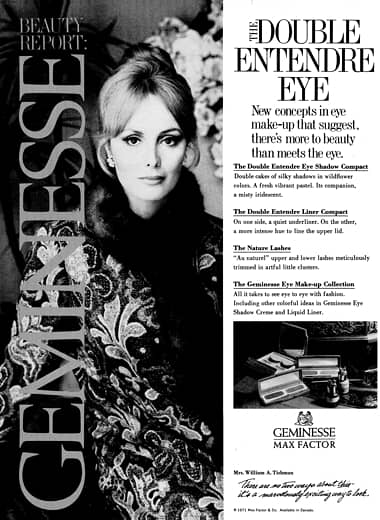
1971 Max Factor Geminesse Double Entendre Eye Shadow Compact, Double Entendre Liner Compact and Nature Lashes.
